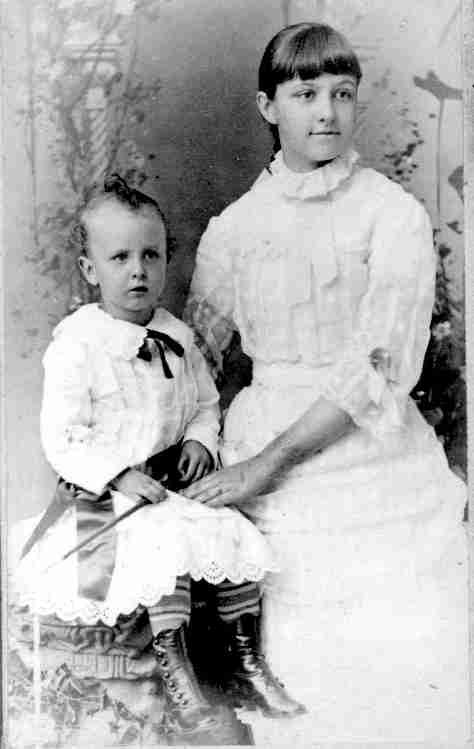
Boy Dress Styles: Collars and Bows

Figure 1.--HBC believes that this American portrait was taken in the 1870s. Notice the differences in the dresses this girl and her little brother wear. The collar and bow are very different as is the sleeve treatment. The eyelet lace trim at the hem probably reflect the boys' age and later in the 19th century would not as commonly be worn by a boy--except infants. Note the stripped socks and brightly colored sash.
|
Some dresses had lace collars worn with large bows, much like a Faultleroy suit. I believe many of these dresses were worn by boys. This appears to have particularly been the case when the decoration was confined primarily to the lace collar and wrist trim. Girls dresses were not generally worn with such large bows and their dresses flunces and trim was not usually limited to priarily the collar. A HBC contributor suggests that while girls did often wear lace collars, that they were commonly round and worn without the destinctive bows worn by the boys. I think collars with bows were much more common on the boys' collars. I can not demonstrate these trends yet--but will pursue the question. HBC stresses, however, while there appear to be general trends, these matters were up to individual mothers who might outfit her son however she fancied.
Collars
HBC has noted two basic collar styles. One is a rounded collar without any break at the throat. The other is a collar in two destinct frontal segnents with a break at the throat. There appdear to be destincr gender conotations for these two styles.
Rounded non-semented collar
Girls commonly wore a collar going all around their neck with no break or at least seeming tomdo at the front. These collars could be of various sizes, but usually not as large as the Fauntleroy collars worn by boys.
Varied semented collar
Boys collars commonly had a break at the throat where it might be buttoned. The basic reason for this is a reflectiion of men's collars. The collar break akkowed for neckwear of various styles to be displayed rather than cobered up. In the boy's case the neckwear was commonly a bow--sometimes quite large which in the late 19th century might cover up much of the collar.
Bows
Bows often wore bows. This was not an imperitive and some boys wore dresses and Fauntleroy suits without bows--but they were a minority. The style and sizes of the bows varied substantially ober time. Girls on the other hand, commonly wore their dresses without collar bows. This is not to say that girls nebver wore collar bows, however it was much less common. When girls did wear collar bows they were usually smaller than the ones worn by the boys.
Christopher Wagner

Navigate the Historic Boys' Clothing Web dress pages:
[Return to the Main boy dress page]
[Pinafores]
[Ringlet curls]
[Smocks]
[Bodice kilts]
[Kilts]
[Fauntleroy dresses]
[Sailor dresses]
[Fancy dresses]
[Dresses: 16th-18th centuries]
[Dresses: Early-Mid-19th century]
[Dresses: Late-19th century]
[Dresses: Early 20th century]
[Difficult images]
[Movie dresses]
Navigate the Boys' Historical Clothing Web Site:
[Introduction]
[Activities]
[Bibliographies]
[Biographies]
[Chronology]
[Clothing styles]
[Contributions]
[Countries]
[Boys' Clothing Home]
Created: October 24, 1999
Last updated: October 24, 2000



